I suspect this Western Grebe may have had a previous and unpleasant experience with a catfish.
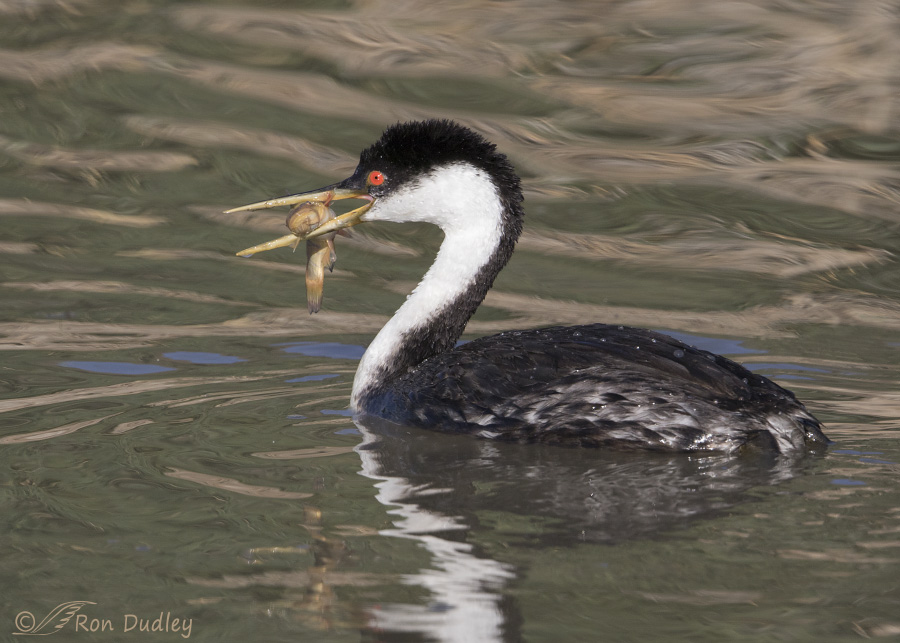
1/2500, f/6.3, ISO 500, Canon 7D Mark II, Canon EF 500mm f/4L IS II USM + 1.4 tc, not baited, set up or called in
Based on bill size and shape I believe this was the male of the pair I photographed yesterday at Bear River Migratory Bird Refuge. The female and their single large juvenile offspring were nearby. By the time I was able to train my lens on him he already had this young catfish in his bill. Typically grebes swallow fish very soon after capture but this time was an exception.
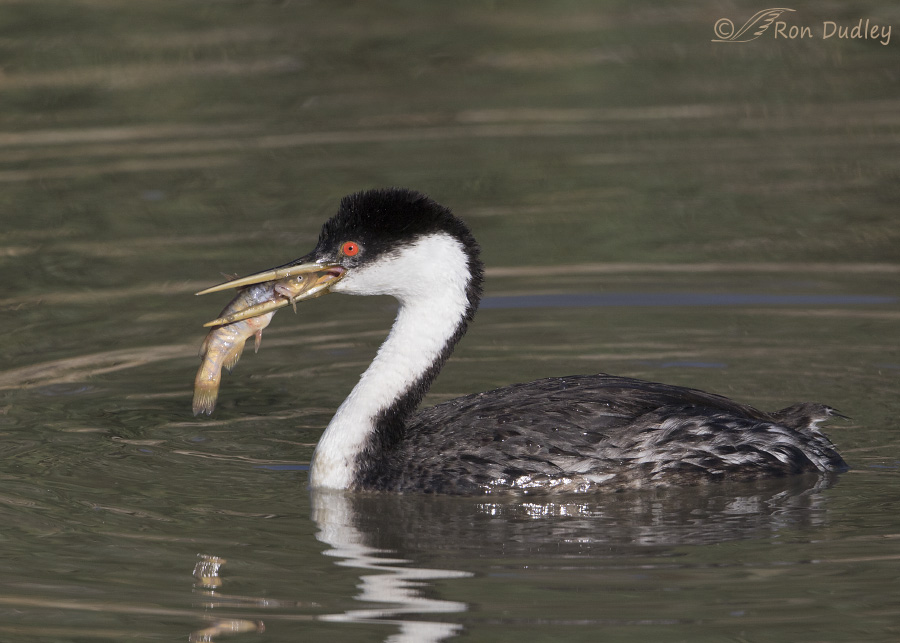
1/3200, f/6.3, ISO 500, Canon 7D Mark II, Canon EF 500mm f/4L IS II USM + 1.4 tc, not baited, set up or called in
Many times he appeared to try to swallow the fish but then abandoned the attempt and…
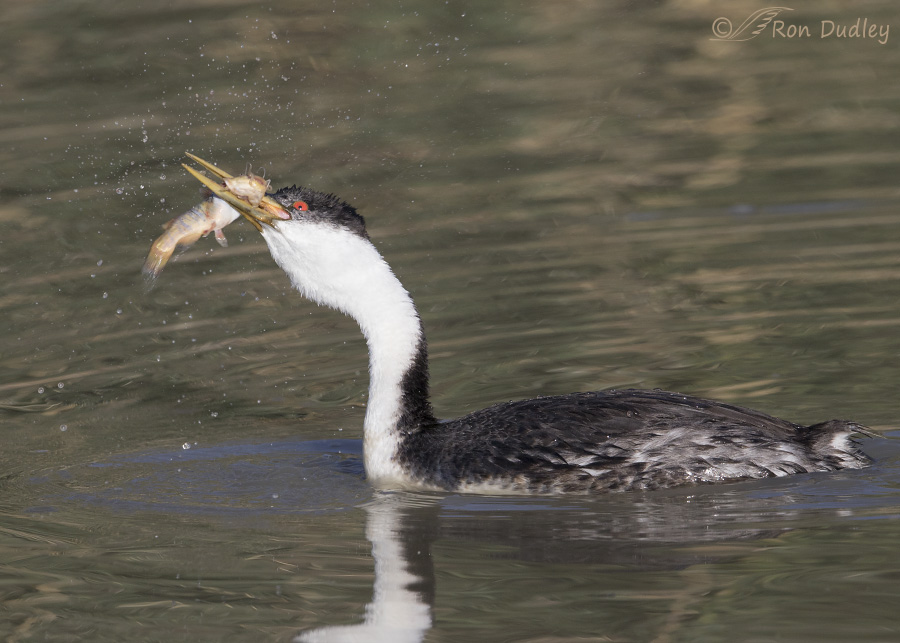
1/2500, f/6.3, ISO 500, Canon 7D Mark II, Canon EF 500mm f/4L IS II USM + 1.4 tc, not baited, set up or called in
went back to beating the crap out of it.
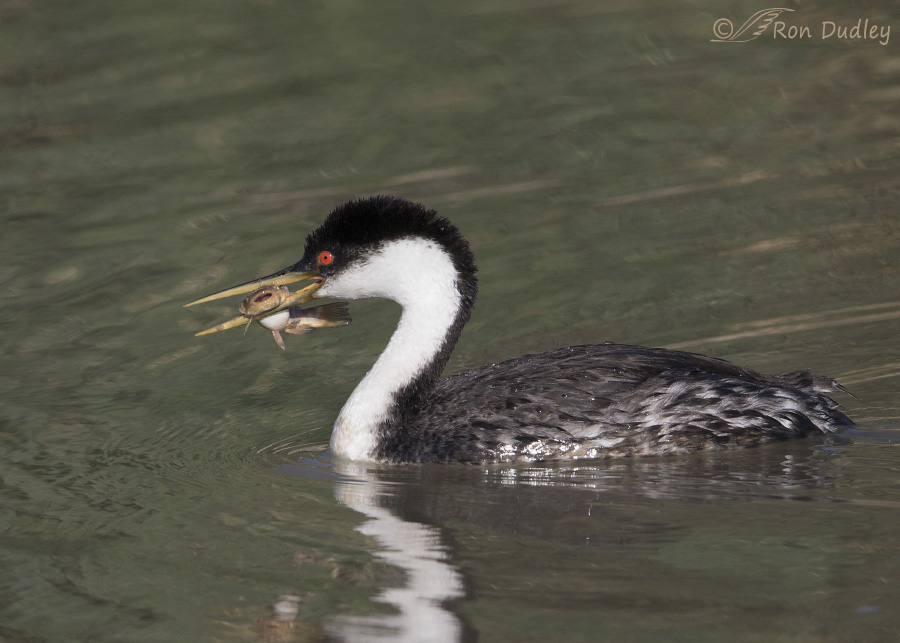
1/3200, f/6.3, ISO 500, Canon 7D Mark II, Canon EF 500mm f/4L IS II USM + 1.4 tc, not baited, set up or called in
Then it would manipulate the fish in its bill…
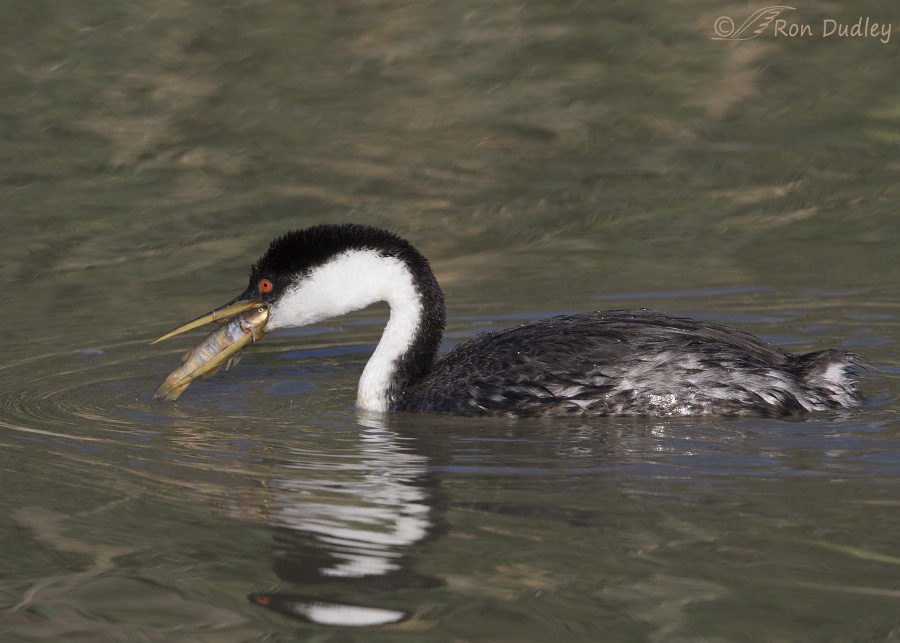
1/3200, f/6.3, ISO 500, Canon 7D Mark II, Canon EF 500mm f/4L IS II USM + 1.4 tc, not baited, set up or called in
and try again.
This went on for eight minutes and I don’t know how long it was occurring before I got the bird in my viewfinder. At first I was puzzled by why it took so long. It certainly wasn’t because the fish was so large he had difficulty getting it down. I’ve seen adult Western Grebes swallow fish much larger than this one with ease.
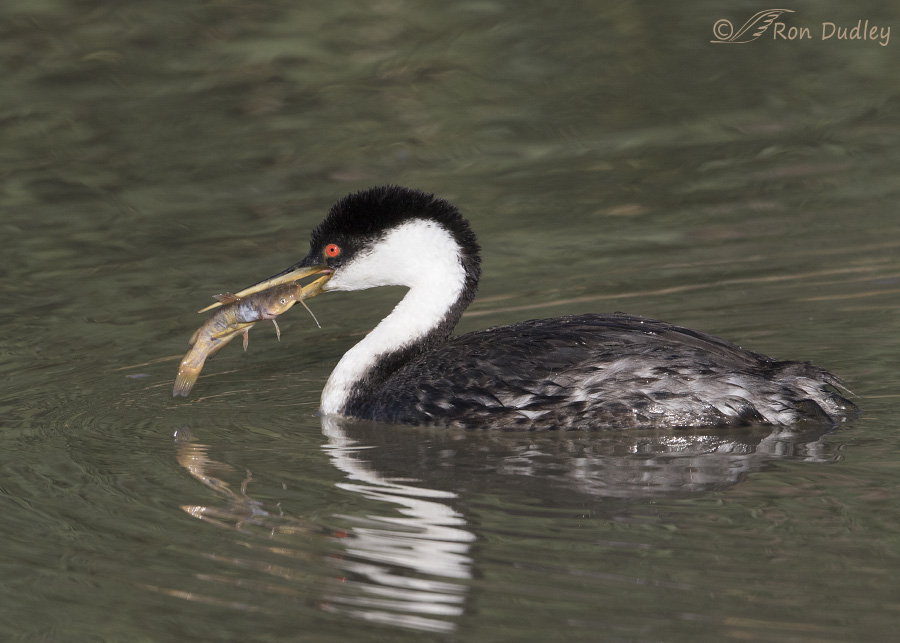
1/3200, f/6.3, ISO 500, Canon 7D Mark II, Canon EF 500mm f/4L IS II USM + 1.4 tc, not baited, set up or called in
But that was before I realized the prey was a catfish. Usually these birds are eating young carp and I’d assumed that to be the case here. I was wrong.
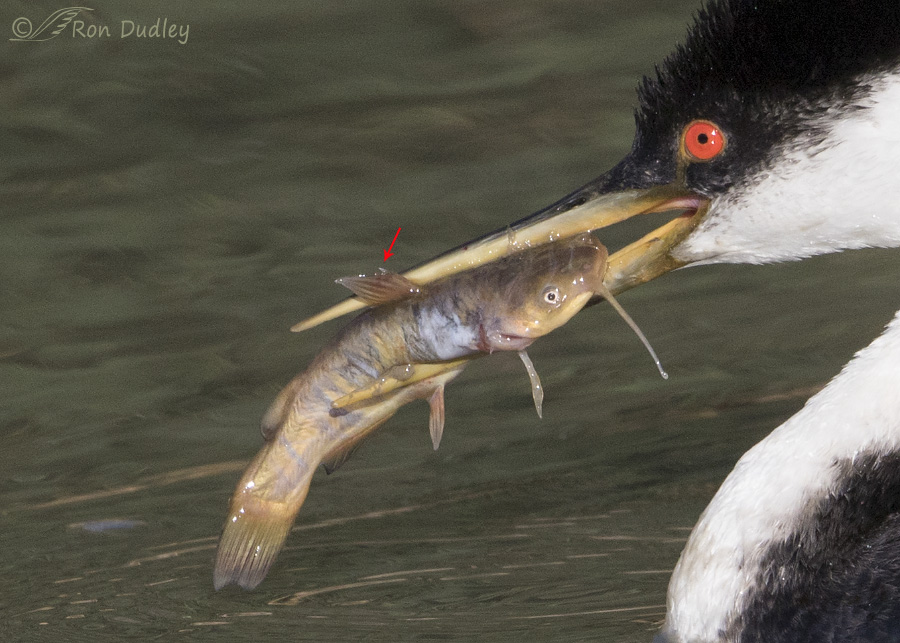
1/3200, f/6.3, ISO 500, Canon 7D Mark II, Canon EF 500mm f/4L IS II USM + 1.4 tc, not baited, set up or called in
A huge crop of the previous image shows one of the barbels (“whiskers”) of the catfish but we can also see one of the dangers of swallowing them.
Most catfish species (electric catfish are the exception) possess strong, sharp bony spines on the leading edge of their dorsal and pectoral fins. Those spines can be defensively erected and they’re particularly sharp and dangerous on small catfish like this young channel cat. In some species they’re even venomous. Here I’ve marked the tip of the spine on the dorsal fin with a red arrow.
I strongly suspect the reason it took so long for the grebe to swallow the fish (if it ever did) was because it was still alive and kept erecting its spines during the beginning of the swallowing process. Catfish are notoriously difficult to kill.
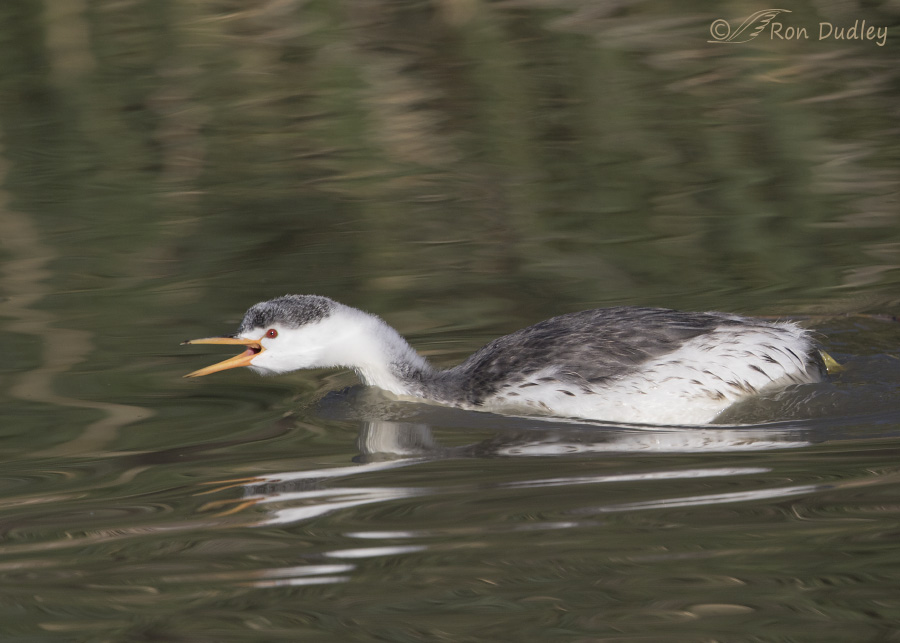
1/3200, f/6.3, ISO 500, Canon 7D Mark II, Canon EF 500mm f/4L IS II USM + 1.4 tc, not baited, set up or called in
During that eight minutes the juvenile grebe repeatedly approached its parent and begged for the fish but the adult refused to relinquish it and always swam the other direction. I suspect it knew the danger the fish would present to its inexperienced youngster.
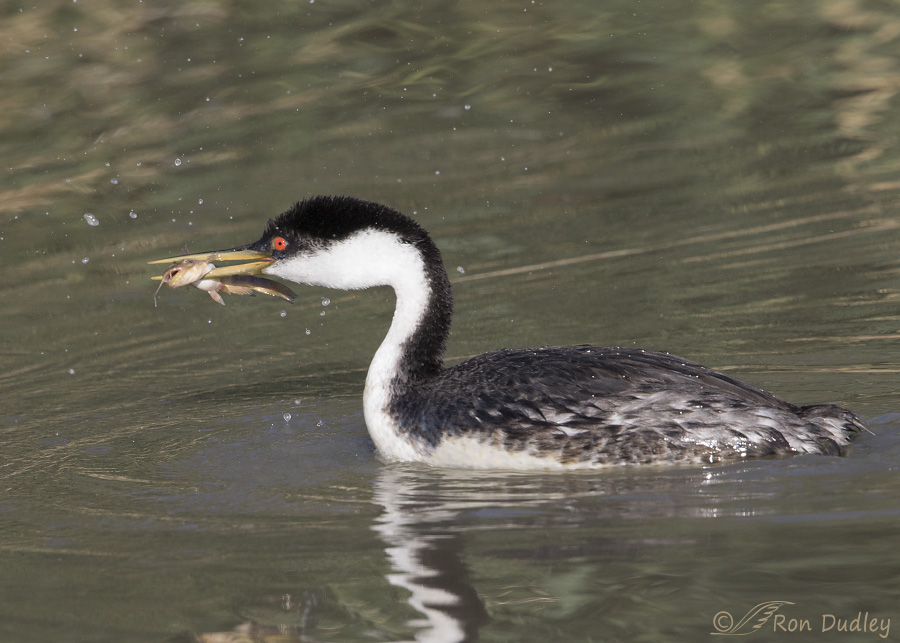
1/2000, f/6.3, ISO 500, Canon 7D Mark II, Canon EF 500mm f/4L IS II USM + 1.4 tc, not baited, set up or called in
The male continued to bash the fish for a very long time but each time he tried to swallow it he abandoned the attempt even after it was obviously dead (by then the fish had been punctured several times by his bill).
I had a hard time keeping my lens on the bird because he kept swimming behind foreground vegetation and once when I moved my pickup to get a clear view again the fish had disappeared in the interim. I don’t know if it was swallowed or deliberately released.
Ron
PS – If you have the interest (and the stomach for it) here’s a link to a google image search of “catfish wounds”. These images illustrate why the grebe was being so careful but be forewarned – many of them are graphic so proceed with caution!
FYI for locals – Bear River MBR is extremely dry and very few birds are accessible. I don’t remember ever seeing it so bone-dry this time of year. And just think – state officials are pushing for several more dams to be built upstream on the Bear River to accommodate development and agriculture which will further reduce flow to the refuge and the severely receding Great Salt Lake.
Our state government at work…


I’ll avoid looking at the link with the catfish wounds – don’t need gruesome. But the behavior of the Grebe is quite interesting. I wouldn’t be surprised if he did drop the fish. It sounds like catfish are too much work to be worth eating.
Great photos! I enjoyed your interesting and well illustrated information on why catfish, especially young ones, are difficult for grebes to eat.
Good. I’m glad you found that interesting, Myriam. Thanks.
Fantastic behavioral shots Ron!
Charlotte
Thank you, Charlotte.
Love that the grebe kept that dangerous morself away from the juvenile. I wonder whether the incessant begging of the youngsters has a good reason? Our magpies continue to feed their noisy and demanding chicks when the chicks are as big as they are. Which I wondered about. And then I read that while the birds have reached full growth, their beaks are still (relatively) soft and not up to stabbing into our sun-baked soil.
Another fascinating series. Thank you. As always.
EC, I wondered if the reason for it is because even though they’re full grown they just don’t have the skills required at that age to catch fish.
I caught a catfish once and someone cleaned it for me but do know they are delicious. Like chicken.Mybe the grebe knows this and figures it is worth the effort.
You may be right, Jane!
I sold some water shares to the state earlier this year for use at Salt Creek WFMA and Public Shooting Grounds WFMA. The guy that called me said that he looks at the ads two or three times per day looking for water shares to buy for the state. I had someone call me the next day and offered be another $9300 but I had to tell him that there was no contract in place but I had made a commitment to sell the shares and would honor that commitment.
If I understand the implications that sounds like good news for the WFMA’s, Chad. And for the birds.
The linked images are pretty gruesome. Being raised on or near the Mississippi River and it’s tributaries in northwestern Illinois, I was taught at a very early age how to properly handle catfish. Extended, the barbs can almost double the girth of the fish and actually lock out and make it impossible to swallow or even get stuck in the throat of a predator, killing both. The locking part is the key to handling them safely. If you slide your hand up the back and get the web of your thumb under the dorsal fin barb and getting your index finger and thumb on the pectoral barbs on either side and put pressure on the extended barbs, they lock in the full extended position enabling a safe, firm grip of the fish. Maybe TMI, but it’s how it’s done safely.
I recently read an article on the changes being deployed at Bear river: https://www.sciencedaily.com/releases/2016/09/160902105843.htm#.V8oHM4qLWyA.facebook. Might be the answer to your habitat question.
Great images as usual, Ron.
Very interesting article, Neil. Sounds like that software model may be key in increasing productive habitat if they only have enough water to do it with after the dams are (probably) built.
Sounds like you’re a very experienced catfish gripper! Next time I see you I’ll have to check your hands for scars!
Actually, I’ve never been spiked by a catfish thanks to dads training. All of my hand scars are from other dumb stuff.
Catfish wounds on humans are gruesome enough. Poor thing. I hope he managed a safer meal.
Arwen, he must have really wanted that fish to put so much effort into it despite the risks.
I’m always learning something new. I didn’t realize that about catfish. At harts a heron was having problems with a fish. Took him over 1/2 hour to swallow it. Kept spitting it out picking it up again. I just couldn’t figure out what was going on..it was a good sized catfish but I’ve seen them swallow larger fish without any problems. …. Made for lots of pictures … But hope it didn’t harm bird???? And yes our government at work Arrrhhhh!!! No common sense.
A half hour is a long time for any bird to work on swallowing a meal, Marina. Bet you have lots of interesting photos of it.
What an interesting series of behavior shots and excellent bird photography. Once again, insert string of superlatives here! Grebes are really interesting birds from a lot of different perspectives. Also love it that the kiddo would rather dad feed him/her than hunt for him/herself! I’m not a big fan of catfish for several different reasons, despite having lived where catfish are king.
Laura, these young grebes continue to beg for food for a very long time after they’re full grown and their begging calls can be very annoying after even a short time with them. I can’t imagine being the parents and having to put up with it for months on end.
Thanks for a most interesting post–I was totally ignorant of the fact that a fish could be so menacing to a predator…….I sure hope those damn dam
projects fail before implementation .
I have similar hopes, Kris, but in Utah whenever development and greed go head to head against conservation and logical thinking the former nearly always wins.
Interesting series…have had my own run-ins with catfish(also called bullheads and hornpouts)…Used to catch them when fishing for sunnies, bass and perch with a special aunt…in a leaky old rowboat that needed constant bailing. I was much happier when she took them off of the hook…it wasn’t easy and that “dagger” really hurt!!!
I’ve never fished for catfish but I understand they’re quite tasty.
Interesting! I know catfish have spines, but had never really considered what a hazard they might be to predators and people particularly when they get large! Thx for the great photo’s and biology lesson!
Judy, I’ve been “spined” a few times by other species (sunfish for example) but it’s my understanding that the spines of channel cats are particularly menacing.
From what I’ve read it’s the smaller catfish that are most dangerous because their spines are so sharp. The spines become less sharp as they get bigger.